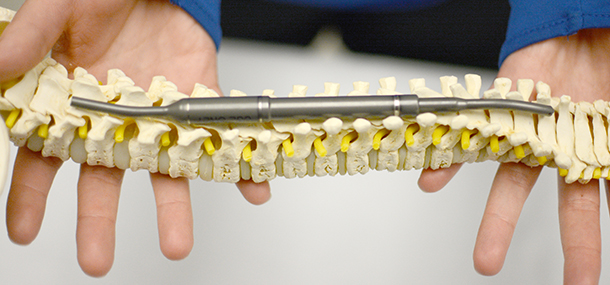
MAGEC Spinal Bracing and Distraction System
New technology comes along all the time at Cincinnati Children’s. We thrive and grow because of it. In the Ultrasound Department, we have begun to work with the Orthopedic Department with their new MAGEC Spinal Bracing and Distraction System. This magnetically controlled growing system is used in children younger than 10 years old with severe spinal deformities. Scoliosis is an abnormal curvature of the spine. Patients with large curves (greater than 50 degrees) can develop a complication called Thoracic Insufficiency Syndrome (TIS). TIS is a condition in which the chest is not able to support normal breathing and lung growth because of the spine deformity.
The MAGEC System consists of an implantable rod and an External Remote Controller (ERC). The rod is surgically implanted along the spine to brace it during growth in order to minimize further curvature. The MAGEC rod and ERC both contain magnetic components to allow lengthening of the rod without the need for surgery. Growing rods allow the spine to continue growing while managing the curve until the child is old enough for spinal fusion.
Like traditional growing rods, MAGEC is a means, not an end. It is a way of bridging the treatment between initial lengthening surgery and spinal fusion. Traditional growing rods were lengthened approximately every six months. This required surgical re-opening of the incision site with pre- and post-radiographs to ensure growth. In an effort to reduce radiation exposure, ultrasound has been introduced as an option to measure the rod lengthening.

 Photo: Using a tool to locate the MAGEC rods
Photo: Using a tool to locate the MAGEC rods
The process begins with the patient going to her orthopedic appointment. She then comes to the ultrasound room for the pre-measurement, lengthening, and post-measurement. The child is positioned lying face down on the exam bed and ultrasound pictures are obtained while scanning along her back.
Once the pre-measurement has been obtained, the lengthening process begins. The ultrasound image shows the orthopedic physician where the ERC should be placed on the back and then pushes a button on the remote control to activate it. The ERC is programmed to only move a certain distance – usually 3-5 mm and takes only a few seconds. After the ERC is finished, ultrasound is used again to measure the amount the rod was lengthened. Most children are brought back about every three months to repeat the lengthening until the rod can no longer be lengthened. Once it has reached the maximum distraction of up to 48mm, the MAGEC rod is surgically removed. This takes about two years to achieve.
 Photo: External Remote Controller (ERC) being placed on patient’s back
Photo: External Remote Controller (ERC) being placed on patient’s back
Some of the benefits of the MAGEC implant include the correction of the curvature of the spine, increase in thoracic spine height, and increased space available for lung growth. The biggest benefit is the non-invasive lengthening of the MAGEC rod without the need for multiple surgeries. The use of ultrasound with each lengthening also decreases the need for multiple x-rays, which reduces radiation exposure.
In addition to the general risks of surgery, the MAGEC implant or attachments have the possibility to bend, loosen, lose distraction, move or break from an accident or during lengthening. If this happens, the device is surgically removed and a second one is placed. Children with the implant may have an allergic reaction from the titanium materials, and could develop worn skin due to the implants. Children with the MAGEC rod implant are cautioned not to participate in extreme sporting activities such as gymnastics, skate boarding, or jumping on the trampoline. They are not allowed to carry a backpack weighing over 20 lbs.
Cincinnati Children’s embraces new technologies such as the MAGEC Spinal Bracing and Distraction System. Both the Ultrasound Department and the Orthopedic Department are excited to work together to achieve the best outcomes for patients with these devices. We are all excited to see what a little MAGEC can do to make a difference for our patients’ futures in the years to come.
Contributed by Amy Winer (RT-US) & Kristina Stenger (RT-US) and edited by Paula Bennett (RT-US).